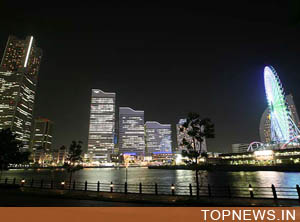Yokohama set to mark 150th anniversary of open port
 Yokohama, Japan - Much of the world was tuned in to Yokohama for a little over 90 minutes in 2002, when it hosted the final of the football World Cup. Brazil's Ronaldo scored two goals to give his team victory over Germany. The city then fell back into the shadow of nearby Tokyo.
Yokohama, Japan - Much of the world was tuned in to Yokohama for a little over 90 minutes in 2002, when it hosted the final of the football World Cup. Brazil's Ronaldo scored two goals to give his team victory over Germany. The city then fell back into the shadow of nearby Tokyo.
But Yokohama will be back in the spotlight in 2009 as it marks an important anniversary - 150 years ago, it opened its port to world trade and thus ushered in a fundamental modernization of Japan. The events dedicated to the anniversary are a good opportunity for tourists to visit the city.
Ice cream is the first thing that comes to Norio Tomioka's mind when he thinks of the port of Yokohama. Japan did not have any until 1859. Nor did beer begin to conquer the taste buds of Japanese until the port was opened to foreign goods.
"At the time the port was opened, Yokohama was still a small village with 100 houses," noted Tomioka, Yokohama's trade representative in Frankfurt. "Today more than
3.6 million people live in the city."
The city's rise began a bit earlier, in 1853, when an American flotilla steamed into Edo Bay and ended Japan's 200-year policy of isolation. A sealed-off zone for foreign residents was set up on an artificial island before the port was opened.
Among the few reminders of olden times is the approximately century-old Yokohama Red Brick Warehouse, which was refurbished several years ago. Businesses, cafes and restaurants have moved into the premises, where silk, tea and wool were once stored.
It is just a short walk from the warehouse to Yamashita Park, which extends along the waterfront. Three other attractions are nearby. The Silk Museum exhibits the process of silk production, to which Yokohama owes part of its earlier wealth. A few buildings away, the Doll Museum displays more than 9,000 dolls from 135 countries.
There is also the Marine Tower, which was built for the 100th anniversary of the port's opening. Rising 108 metres, it is considered the world's tallest lighthouse. Its observation deck affords a beautiful view of the city lights in the evening.
Yokohama's Chinatown lies at the foot of the tower. Although the district has lost much of its former charm, more than 500 Chinese restaurants and shops still lend it a special flair. Gokucha-kappo, for example, has an enormous number of tea varieties, and Koseido Yakkyoku woos customers with a complete range of Chinese herbs, spices and oils for all ailments.
Chinatown adjoins the quarter of Yamate-cho, where many foreign merchants once had their mansions. The quarter's Yamate Museum gives insight into the lives of the first foreigners in Japan.
Minato Mirai 21 ("Port Future 21"), on the other hand, is a quarter totally directed toward the future. The nearly 300-metre-high Landmark Tower overtops a skyscraper ensemble including the Cosmo Clock 21, a Ferris wheel, and a billowing sail-shaped hotel.
On the 69th floor of the Landmark Tower is the Sky Garden, an observation platform offering a fine panoramic view stretching from Tokyo in the north-west to the usually snow-capped Mount Fuji in the west.
Internet: www. city. yokohama. jp/en, www. welcome. city. yokohama. jp/eng/tourism (dpa)